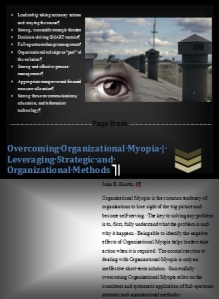Breaking ⛏ Through Siloed Organizations First Requires Leadership Awareness! 類
Silos exist in practically every company, business, and organization. For profit or non profit … doesn’t matter. I’ve even identified silos in solo proprietorships.
The natural tendency of leaders is to “tear down the silos.”
Oh, I’m sure you’ve heard it all before … maybe you’ve even said it.
Everyone knows silos are bad!!!
Right?
Unfortunately, very few know why silos exist in the first place.
Unfortunately, very few understand why and who created the silos.
And, unfortunately, very few understand why playing “whack a silo” in your company doesn’t work!
The first step in dealing with silos in your organization is to learn why they formed in the first place and why you’ll NEVER get rid of them.
I challenge you to read Overcoming Organizational Myopia and learn not only why they form, but how to deal with them.
Increase your awareness!!!
#success #incubator #business #coaching #consultants
#overcomingorganizationalmyopia




 Silos exist in nearly every organization. Organizations’ that suffer from silos are affected by what I refer to as
Silos exist in nearly every organization. Organizations’ that suffer from silos are affected by what I refer to as 
